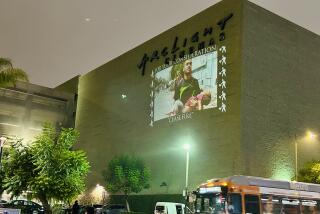A Project That Gives New Meaning to the Term ‘Art House’
- Share via
After six months of organizing and negotiating, artist Karen Atkinson thought her unusual notion to exhibit original artworks in slide form at movie theaters between films was about to happen.
Ten works, all of them original images designed for the project by artists--nearly all of whom are from Southern California--were to be projected on 20 screens at two movie theaters: the AMC Old Pasadena 8 and the Sony Magic Johnson Theatres in Baldwin Hills. Now, only six of the artworks have been approved by the organization responsible for the theaters’ filler time, leaving some of the artists charging censorship.
Atkinson, co-curator of the project, has paid $6,000 as a fee to show the slides, which are hardly mistakable for popcorn ads. They use visual imagery and text to make social or political commentary, some of it quite subtle, some of it more direct.
Atkinson and all of the artists knew from the start that they had to work within the printed guidelines of the private National Cinema Network, which oversees the filler material at movie theaters nationwide and states in its guidelines that it shall determine what gets screened.
Indeed, in working with the NCN, all the artists have had to somewhat alter their slides, either by changing text, or, in most cases, adding their names to the images to clearly distinguish the works from NCN material, said Atkinson, who curated “PROJECTIONS: intermission images” with Washington, D.C., artist Sylvia Bowyer.
But at the last minute, the NCN--which first saw most of the works in October--raised new objections, said Atkinson, who has made slide art since the 1970s.
Among the rejected slides is Pat Ward Williams image of a black man’s hand beside the statement, “copying everybody else, all the time, one day the monkey . . . cut his own throat.”
Yong Soon Min’s nixed work adds the words “Colorblind Meritocracy” to a dollar bill’s pyramid symbol, along with the legend “Colorblindness is a congenital defect not a social cure,” a comment, she says, on battles over affirmative action and Proposition 187.
The six NCN-approved slides will be shown for six weeks starting Friday at the Pasadena theater and starting Feb. 9 in Baldwin Hills.
“When we presented the slides to the NCN,” Atkinson said earlier this week, “they told us what changes to make to get the slides accepted, so in all good faith, we negotiated to make the slides work for them, but they didn’t tell us [all of] what was not acceptable. [The rejected slides were] a huge surprise after we bent over backward to make things OK for them.”
The NCN, however, which requires that all slide imagery be “rated G,” devoid of references to alcohol and “pain” or “stress,” asserts that its concerns about some of the slides had been voiced from the start and that it is following its usual sign-off procedures.
Its regulations note that all photographic content “is subject to review by NCN senior management,” which gives final approval.
“Not all the slides were [shown to the NCN] at the beginning,” said Michele Lee, executive director of marketing for the Kansas City-headquartered NCN, “and [the NCN told the curators that] certain slides were considered controversial at the beginning.”
Asking the curators to change the slides did not mean final approval would be automatically given upon execution of the changes, Lee said. “We made it very clear that [the NCN staffer who asked for the changes] was not the only decision-maker” in a multilayered approval process.
The NCN, which leases time from individual theaters to run ads and its “On-Screen Entertainment Program” of movie facts, serves audiences of all ages, Lee said, “so we’re very, very careful. Slides can have no nudity and we don’t want any controversial issues or anything that could be construed as such.” Pain can’t be mentioned because “our patrons go to theaters to have an enjoyable experience.”
“Projections” artist Martha Rosler of New York, who created a rejected work with Josh Neufeld, is dismayed that the NCN thinks “the public needs to be protected from indisputable fact.” Her slide, with an image of a schoolhouse and a prison, asserts that the “California budget for prisons now exceeds [the state] budget for higher education,” a “fact” printed in the New York Times and elsewhere, she said.
Other than to call the rejected slides potentially controversial or not “G-rated,” Lee would not say what the NCN found objectionable. She did say that racial issues had no bearing.
“If I were a parent [watching a film] with a 5-year-old,” Lee said, “I just wouldn’t feel comfortable with certain of those slides.”
Earlier in the process, Atkinson had said she would claim censorship only if slides were shown, then yanked by the NCN, so she is hesitant to make the charge now. She says she’s just reeling from all the negotiation that the project, which she has been trying to launch for a decade, has required.
“We embarked on the project with full knowledge” of potential road blocks, she said, which is what made it an interesting challenge. “It’s just been a little more interesting than we thought.”
Atkinson plans to show all 10 slides, including her own, at a free, public reception Thursday at 7 p.m. at the Pasadena theater, and later at traditional art venues.
More to Read
The biggest entertainment stories
Get our big stories about Hollywood, film, television, music, arts, culture and more right in your inbox as soon as they publish.
You may occasionally receive promotional content from the Los Angeles Times.










